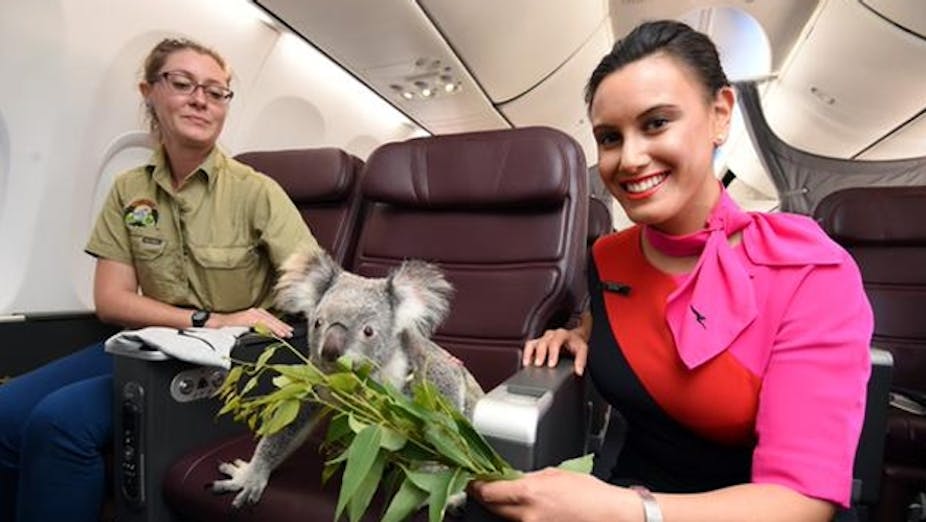Four female koalas have just made their debut in front of an adoring public at Singapore Zoo – the latest in a long line of animals used for diplomatic purposes.

The koalas are on loan from Australia to mark the 50th anniversary of Singapore’s sovereignty, as well as 50 years of diplomatic relations with Australia.
As Australian Foreign Minister Julie Bishop’s media release says, the koalas’ visit will “further build on our long-standing constructive relationship”. The four koalas will stay in Singapore for six months for now, but the gift will be made permanent once Singapore Zoo can support a koala colony.
The involvement of iconic animals in international diplomacy has a long history.
Arguably, the best known of the world’s animal ambassadors has been the giant panda. Between the 1950s and 1980s, China presented two dozen pandas to countries with which it wished to improve its relations.
Other pandas were loaned, such as Xiao Xiao and Fei Fei, exhibited at Taronga Zoo, Sydney, and Melbourne Zoo to mark Australia’s Bicentenary in 1988.
While the practice of giving pandas permanently to other countries has now stopped, “panda diplomacy” continues with the Chinese government lending pandas, including the pair Wang Wang and Funi at Adelaide Zoo.

The tragic tale of Winston the platypus
Australia’s diplomatic deployment of native animals to other countries became more formalised during World War II.
The platypus’s high popular appeal and scientific interest meant that it was a highly valued diplomatic gift.
Australia’s first platypus diplomat left Melbourne in 1943, sailing on the MV Phillip to England even as World War II raged in Europe.
He was named Winston in honour of the British prime minister, who had expressed an interest in acquiring the animal to H.V. Evatt, minister for external affairs and attorney-general at the time.
Tragically, Winston the platypus died only days before landing in Liverpool. Churchill wrote to Evatt that he was:
grieved to have to tell you that the platypus you kindly sent me died on the last few days of its journey to England. Its loss is a great disappointment to me.
Churchill would have to make do with a stuffed platypus that had been previously sent to him by Evatt, which he apparently displayed proudly on the prime ministerial desk.

Bound for America
A few years later, three more platypus envoys left Australia, this time bound for the United States, arriving in New York on April 25 1947.
They were a gift from the Australian government to the American people in recognition of American wartime service to Australia – a “gesture of closeness and goodwill”, declared Australia’s ambassador to the United States, Norman Makin.
Housed at the Bronx Zoo, the cosmopolitan monotremes attracted more than 4000 visitors a day in the months following their arrival.
With the Australian flag flying over their enclosure, considerable positive press were generated about Australia, including a front-page feature in The New York Times.
But difficulties with husbandry and a desire to have tourists come to Australia to see our native animals make it unlikely that more platypus will leave Australia in the near future. Instead, the diplomatic burden has shifted to an animal that is less of an oddity and trades more on cute appeal: the koala.
Koala diplomacy
Back in 1983, the then federal tourism minister, John Brown, did his best to steer Australia’s overseas image away from the koala, declaring (in a speech reported on the front page of The Age) that they were “rotten little things” and tourists would discover:
it’s flea-ridden, it piddles on you, it stinks and it scratches.
But two generations later, Brown’s opinion has largely been forgotten. Koala diplomacy has never been bigger.
This was easy to see last November at the G20 Summit in Brisbane, when grinning world leaders posed one by one holding an obliging koala.

According to the BBC, the summit’s “most memorable images” were of the G20 leaders “cuddling up to koalas”.
No doubt our koalas, Paddle, Pelita, Chan and Idalia, will generate at least as much, if not more, interest in Singapore as pandas have created in Australia or platypuses did in the United States.

As “koala mania” takes hold in Singapore, we can reflect on the capacity of iconic, charismatic animals to communicate messages of goodwill across barriers of language and culture.
As John Brown suggested back in 1983, using native animals to promote Australia may risk selling short a dynamic, multicultural, resource-rich nation.
But our unique platypus, koalas and kangaroos do allow Australians to avoid harder decisions about how to portray ourselves to the world.
Pictures of cuddly animals are an effective way to market ourselves to the world as a peculiar but attractive “land down under”. They provide powerful images that nothing else – from a pile of iron ore, to live sheep on a ship, or a naval patrol vessel – can match.

